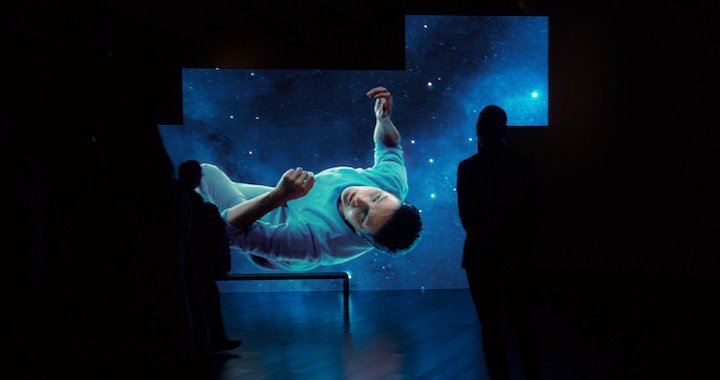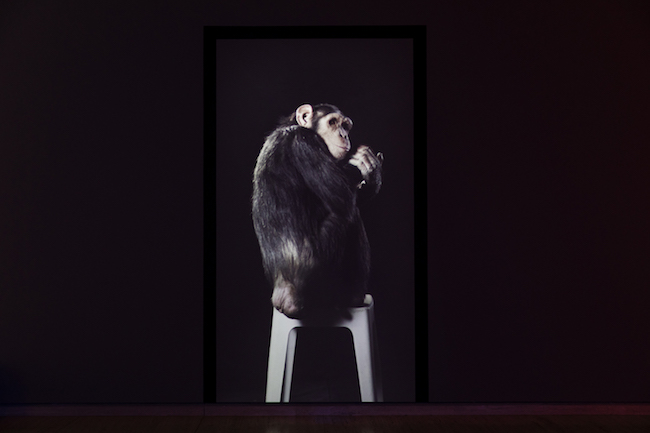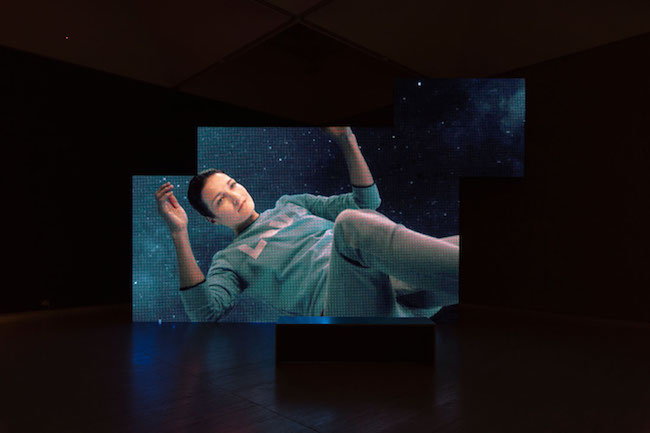
3 + 3
An express-interview with Finnish artists Tuomas Aleksander Laitinen and Eija-Liisa Ahtila
02/05/2018
The superposition principle, also known as superposition property, is a quantum mechanical term that refers to an overlapping situation. It states that “for all linear systems, the net response caused by two or more stimuli is the sum of the responses that would have been caused by each stimulus individually”. Marking its 45th anniversary, the Biennale of Sydney has borrowed this quite complicated term to underline the most urgent issues in the international contemporary art scene. The first Biennale of Sydney was held as a part of the opening celebrations of the Sydney Opera House and was the first exhibition of this kind in the Asia-Pacific region.
This year the curator of the 21st edition of the Biennale of Sydney is Mami Kataoka – the Chief Curator of the Mori Art Museum in Tokyo. For the concept of this year’s exhibition, she was inspired by the late Danish physicist Niels Bohr and his theory of superposition. From 16 March until 11 June, the work of 70 artists from 35 countries is being exhibited in various locations throughout Sydney. Amongst them, work by the internationally known Finnish artists Tuomas Aleksander Laitinen and Eija-Liisa Ahtila.
Tuomas A. Laitinen is both an artist and a musician whose creative work includes moving image, 3D animation, light, sound, installation and spatial interventions. At the Biennale he is participating with his latest commission, Dossier of Osmosis – an event within which performers will explore the tension between natural processes and the regulatory structures imposed upon them.
Eija-Liisa Ahtila, however, is a visual artist and filmmaker who is noted for her experimental approach to narrative storytelling. In her latest installation, Potentiality for Love, Eija-Liisa Ahtila deals with the potential for empathy and love towards other living beings.
We asked each of them three questions about their work and participation in the Biennale of Sydney.

Tuomas Aleksander Laitinen, Dossier of Osmosis (2018)
In your works, you mainly seek to deconstruct binary logic and accept structures that rely on a system of connections. What exactly is this system, and how did you become interested in this topic?
Tuomas Aleksander Laitinen: There are multiple ways to approach this undercurrent. One is rooted in the discussions of human influence in ecological shifts. One peculiar thing that often emerges from these conversations is the rhetoric that creates a division between humans and nature. And this essentialising idea of “nature” is then very easily turned into attempts to violently categorise bodies through a binary lens. For example, this happens often in relation to gender, and also in the process of defining this so-called ”nature” through a (petro-tech-eco-)capitalist system as something that either yields profit or not. I am trying to find a fluid language that would allow more open ways to think about these diverse and complex experiences of living within the ecosystem.
One very important question in this work is that of production of knowledge and the mechanics and technologies that are embedded in these processes. Who has access to tools, figures, charts and devices that produce information? And most importantly, what power structures emerge from these complicated circumstances? In the work, the epistemological frame can be seen through references to climate data charts and absurd semi-fictional recipes that reveal some of the substances used in the work.
In my recent activities, I have been gravitating towards a mode where the agency of living substances/beings is a crucial premise. I propose that this agency should not be fixed to any essentialising positions or, even worse, just mundanely limited to mere representations or reflections of life forms, devices, materials, and tools that circulate the world.

Tuomas Aleksander Laitinen. Photo: Frame Contemporary Art Finland, Sirja Moberg
In biology, osmosis refers to the movement of a solvent through a semipermeable membrane. What is your Dossier of Osmosis?
T.A.L.: I approach this concept through porous layers of interdependent materials and asemic poetry made of glass objects. This combination is stacked in transparent layers that form sculptural tables. In the piece, the guide layers are alive with biochemical reactions made from pulverised seaweed, lichens, copper sulfate and other substances. These base layers will ultimately perform the the visual aspect of the work, i.e. colour, texture, and opacity.
In terms of form, there are a few key ideas in the work. One path was to think of them as game tables, as a kind of a game of osmosis in which material agency is blending with language and, as a result, changes the rules of the game as it is constantly transmutating. In this scenario, the small glass objects could be seen as game tokens.
The second phase was to think of them as a ceremonial table for intimate communal activity (like a tea ceremony). Here, the the small glass objects placed in the layers could be seen as archaeological artefacts.
And finally, the third stage was to envision the tables as giant petri dishes where material entanglements are free to evolve and live.
Besides weaving those aforementioned threads together, I thought about the concept of osmosis in a way that has the potentiality to be a soft catalyst for melting divisions between nature, culture and technology.
In the audio section of the work, these ideas are further examined in a text written by Nora Khan. It is audible in the exhibition space via ultrasonic speakers as a speculative user manual/epic poem that provides clues to the various ways that the objects contained in the installation could be used or interpreted.
This is the first time you are participating in the Biennale of Sydney. What are your expectations?
T.A.L.: It was great to be able to explore Mami Kataoka’s curatorial touch throughout the exhibition. There are many underlying currents that reward closer inspection and reveal subtle connections in the works.

Eija-Liisa Ahtila. Potentiality for Love, 2018
Eija-Liisa, for you this is your second time participating in the Biennale of Sidney. In 2002 your work was about the non-rational in the ordinary lives of teenagers and single mothers; today you speak about the potential for love and empathy. What has changed (or remained the same) in your point of view as an artist over the years?
Eija-Liisa Ahtila: Yes, in 2002 the work was If 6 was 9, a three-screen-installation which dealt with teenage girls and sexuality. I have continued working with moving images, but a gradual shift has occurred during these years from human-centred dramas towards a more ecologically oriented narration. Before Potentiality for Love, showing now in Sydney, I did a four-screen installation called Studies on the Ecology of Drama. It looks at the possibilities for moving away from anthropocentrism and finding other means and perspectives to show the world through moving images.
How would you assess the potential for love nowadays?
E.L.A.: In a way, that kind of question pushed me to work with the theme. I was writing a script for another piece, and time and again returned to the problem of how to justify the turn towards other living beings. Can such things as empathy, respect and equality be felt towards non-humans? If so, what can they be based on? What is it in us humans that makes us capable of basing our action on those concepts? At what point does love enter our lives and what kind of a shape does it take? How does it exist as an element in our concept of humans?
These questions formed the starting point for the work. One of the first things I used to approach the idea was the concept of potentiality, which has a long history in Western philosophy. To put it short, I turned to Giorgio Agamben and his beautiful text, On Potentiality.
A straight answer to your question would be that I don’t know. But I did approach it with the work and tried to find the means to present this faculty that may lie hidden, but exists as potentiality.

Eija-Liisa Ahtila. Potentiality for Love, 2018
In the piece Potentiality for Love, you use sculpture and moving image technology to focus attention on the point where love is born. How did you come to a decision that this combination of installation elements would precisely mirror the essence of your conception?
E.L.A.: I had decided to make an installation that would suggest a way to look at the topic. I built it gradually, piece by piece, and assigned a function to each piece.
The first part was to give form to a memory of the primal unity with mother, then separation and becoming a subject. I thought of the memory consisting of both something material as well as an image. This led me to those old-fashioned LED modules which, when one looks at them from a distance, form an image, and then when one stands close to them, one experienced the huge material structure which the modules form.
I thought this would correspond to the memory of mother: first, the vision of her, and then, when you are in her lap as a child, the memory of her materiality.
The second part of the installation is made up of two tables with monitors which present the arms of another primate, a chimpanzee. One can do an experiment with the table to kind of visually replace one’s own hand with that of the chimp. This, I thought, would be a way to approach the inevitable question in this context, that is, the question of the difference. Who we are, and what is the origin of the others?
The third part in the installation is a video projection on a wall which shows the chimp sitting in a doorway and looking away to another space, then turning to us a couple of times – to the space where the viewers are.